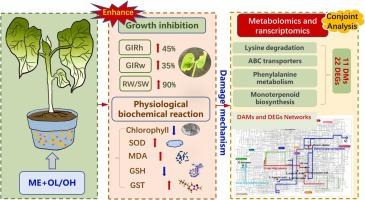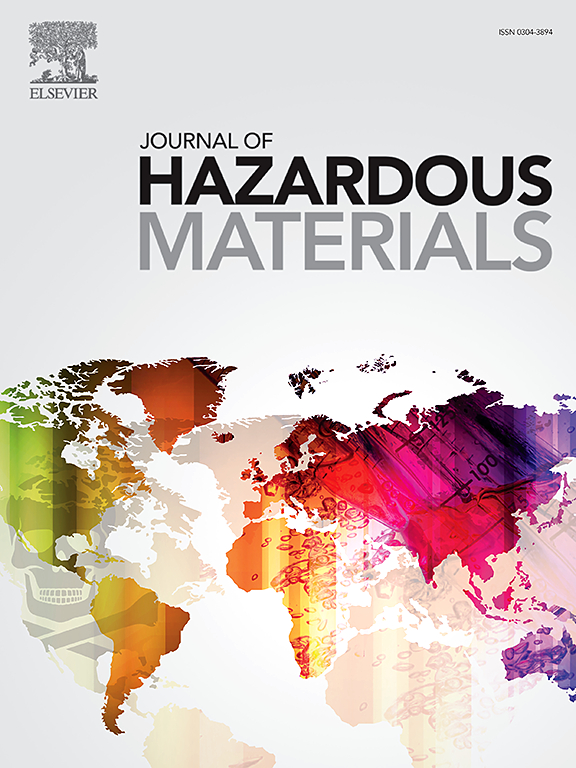有机硅佐剂与 S-甲草胺复配对金光菊的毒性机理
IF 12.2
1区 环境科学与生态学
Q1 ENGINEERING, ENVIRONMENTAL
引用次数: 0
摘要
在农业中广泛使用 S-甲草胺(ME)来抑制杂草和提高作物产量,尤其是在栽培木樨(Vigna angularis)时。然而,除草剂中有机硅佐剂的应用对非目标作物有潜在威胁。本研究调查了当 Vigna angularis 接触 ME 和一种常见的有机硅佐剂时的毒性症状和机制。结果表明,ME 会抑制 V. angularis 幼苗的生长,而添加佐剂会加剧 ME 的负面影响。根据幼苗的生长指数,佐剂会使 ME 的毒性增加 84-96%。此外,幼苗的叶绿素含量、根系渗透性和抗氧化指标也受到了不利影响。代谢组学和转录组学的综合分析表明,差异丰度代谢物(DAMs)和差异表达基因(DEGs)主要富集在四个方面:"赖氨酸降解"、"ABC 转运体"、"苯丙氨酸代谢 "和 "单萜生物合成"。涉及11个DAMs和22个DEGs的代谢途径和基因调控网络与受ME和佐剂影响的生理过程有关。这项研究为除草剂及其佐剂在农业生产中的应用提供了指导,以尽量减少对非目标作物的不利影响。本文章由计算机程序翻译,如有差异,请以英文原文为准。

Toxicity Mechanism of Organosilicon Adjuvant in Combination with S-metolachlor on Vigna angularis
The widespread use of S-metolachlor (ME) in agriculture to suppress weeds and boost crop yields, particularly in cultivating Vigna angularis, is well established. However, the application of organosilicon adjuvants with herbicides has potential threats to non-target crops. This study investigates the toxicity symptoms and mechanisms when V. angularis is exposed to ME in conjunction with a common organosilicon adjuvant. Results indicate that ME inhibits the growth of V. angularis seedlings, and adding adjuvants could aggravate the negative effects of ME. According to the growth index of seedlings, the adjuvant increased the toxicity of ME by 84-96%. Additionally, the chlorophyll content, root permeability, and antioxidant indicators in the seedlings were also adversely affected. Integrated metabolomics and transcriptomics analyses reveal that differentially abundant metabolites (DAMs) and differentially expressed genes (DEGs) are mainly enriched in four ways: "lysine degradation," "ABC transporters," "phenylalanine metabolism," and "monoterpenoid biosynthesis." The metabolic pathways and gene regulatory network involving 11 DAMs and 22 DEGs are associated with the physiological processes affected by ME and the adjuvant. This study provides guidance for the application of herbicides and their adjuvants in agricultural production to minimize adverse effects on non-target crops.
求助全文
通过发布文献求助,成功后即可免费获取论文全文。
去求助
来源期刊

Journal of Hazardous Materials
工程技术-工程:环境
CiteScore
25.40
自引率
5.90%
发文量
3059
审稿时长
58 days
期刊介绍:
The Journal of Hazardous Materials serves as a global platform for promoting cutting-edge research in the field of Environmental Science and Engineering. Our publication features a wide range of articles, including full-length research papers, review articles, and perspectives, with the aim of enhancing our understanding of the dangers and risks associated with various materials concerning public health and the environment. It is important to note that the term "environmental contaminants" refers specifically to substances that pose hazardous effects through contamination, while excluding those that do not have such impacts on the environment or human health. Moreover, we emphasize the distinction between wastes and hazardous materials in order to provide further clarity on the scope of the journal. We have a keen interest in exploring specific compounds and microbial agents that have adverse effects on the environment.
 求助内容:
求助内容: 应助结果提醒方式:
应助结果提醒方式:


